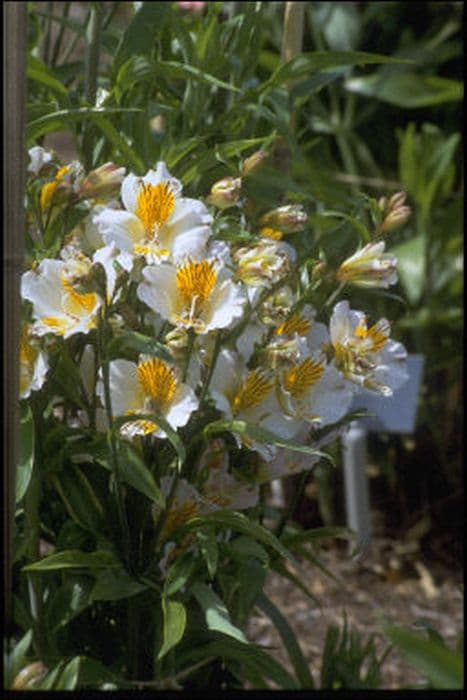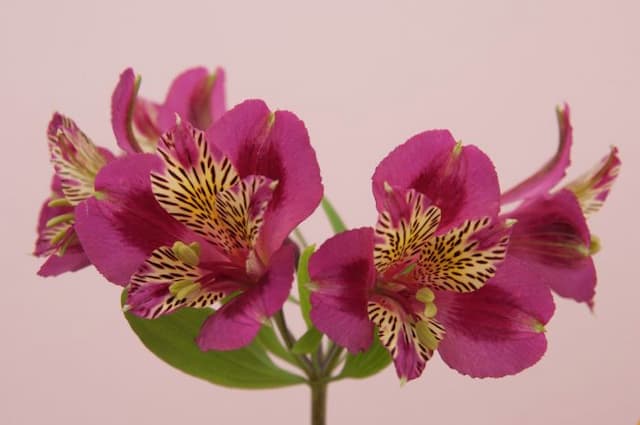Peruvian Lily Alstroemeria 'Angelina'

ABOUT
Alstroemeria 'Angelina', commonly known as the Peruvian Lily or Lily of the Incas, is a stunning herbaceous perennial characterized by its showy and colorful flowers. The blooms display a striking mix of pink, yellow, and orange hues often speckled or streaked with dark markings. The petals are slightly curved, giving the flowers a distinctive, almost trumpet-like appearance that adds to their exotic look. The foliage of Alstroemeria 'Angelina' comprises slender, lance-shaped leaves that usually bear a distinctive light green to mid-green color. These leaves may be somewhat twisted or spiral along the stem, creating an interesting visual texture. The plant's overall appearance is lush and vibrant, with the flowering stems rising above the foliage and often branching, leading to a dense display of blooms that can be quite eye-catching in any garden or floral arrangement. Moreover, the Peruvian Lily has a clumping habit, with multiple stems emerging from a central point at the plant's base, making it an attractive, bushy addition to garden borders or pots. The flowers of Alstroemeria 'Angelina' have the trademark appearance of the genus, with each individual blossom consisting of three petals and three sepals that are similar in color and pattern. This symmetry adds to the beauty of the flower, making it a popular choice for bouquets and decorations. Overall, the Alstroemeria 'Angelina' offers a delightful display of color and form through its appealing flowers and attractive foliage, making it a favorite among both gardeners and florists.
About this plant
 Names
NamesFamily
Alstroemeriaceae
Synonyms
Peruvian Lily, Lily of the Incas, Parrot Lily, Peruvian Lily of the Incas
Common names
Alstroemeria 'Angelina'.
 Toxicity
ToxicityTo humans
The Peruvian Lily, the common name for Alstroemeria, has a low level of toxicity to humans. If ingested, it can cause mild gastrointestinal upset, including nausea, vomiting, or diarrhea. Handling the plant may also cause skin irritation or an allergic reaction in some individuals. It's advisable to wash hands after handling the Peruvian Lily and to keep it out of reach of children who might accidentally ingest parts of it.
To pets
For pets, the Peruvian Lily can be harmful if ingested. It contains tulipalin-like allergenic compounds which can cause vomiting, diarrhea, and drooling in cats and dogs. In some cases, ingestion may lead to more serious symptoms such as abdominal pain or lethargy. Contact with the plant may also result in dermatitis. Therefore, it's recommended to keep the Peruvian Lily away from pets and seek veterinary care if you suspect they have ingested any part of it.
 Characteristics
CharacteristicsLife cycle
Perennials
Foliage type
Deciduous
Color of leaves
Green
Flower color
Mixed
Height
2-3 feet (60-90 cm)
Spread
1-2 feet (30-60 cm)
Plant type
Herb
Hardiness zones
7
Native area
South America
Benefits
 General Benefits
General Benefits- Long-lasting blooms: Alstroemeria 'Angelina' flowers have a long bloom period, providing color and interest in the garden for many weeks.
- Attracts pollinators: Its vibrant flowers attract bees, butterflies, and other pollinators, which are essential for a healthy ecosystem.
- Versatile cut flowers: The blooms of Alstroemeria 'Angelina' are popular in floral arrangements due to their longevity and beautiful colors even after being cut.
- Low maintenance: This plant is relatively easy to care for, requiring only occasional watering and fertilization.
- Drought tolerance: Once established, Alstroemeria 'Angelina' can tolerate periods of drought, making it suitable for water-wise gardens.
- Color variety: The plant offers a range of colors, which can add visual interest and complement other plants in a garden setting.
 Medical Properties
Medical PropertiesThis plant is not used for medical purposes.
 Air-purifying Qualities
Air-purifying QualitiesThis plant is not specifically known for air purifying qualities.
 Other Uses
Other Uses- Photography subjects: With their vibrant colors and intricate shapes, Peruvian lilies are excellent subjects for photographers, especially those specializing in macro and botanical photography.
- Artistic inspiration: Artists may use the striking appearance of Peruvian lilies as inspiration for paintings, drawings, and other forms of art.
- Teaching tool in botany: The distinctive features of the Peruvian lily can be used to teach botanical concepts such as symmetry, petal arrangement, and pollination mechanisms.
- Culinary decoration: Although not edible, Peruvian lily petals can be used as a decorative element on plates or platters for culinary presentation, as long as they do not come into contact with food.
- Dye source: The petals of Peruvian lilies contain pigments that could potentially be used as a natural dye for fabrics or other materials.
- Table arrangements: The sturdy stems and long-lasting blooms of Peruvian lilies make them suitable for use in live table arrangements for events and gatherings.
- Educational crafts: Schools may use images or actual blooms of Peruvian lilies for educational crafts, like creating paper versions or studying flower parts.
- Theme gardens: Peruvian lilies can be included in gardens that are designed around a specific theme, such as a "Shakespeare Garden" where each plant is referenced in one of his works.
- Motif in design: The patterns and colors of Peruvian lilies can be used as a motif in fabric designs, wallpaper, or other interior decorating elements.
- Fragrance inspiration: While the Peruvian lily itself may not be particularly fragrant, its image can inspire the creation of floral fragrances or be included in potpourri for its visual appeal.
Interesting Facts
 Feng Shui
Feng ShuiThe plant Alstroemeria, commonly known as Peruvian Lily, is not used in Feng Shui practice.
 Zodiac Sign Compitability
Zodiac Sign CompitabilityThe Peruvian Lily is not used in astrology practice.
 Plant Symbolism
Plant Symbolism- Friendship: The alstroemeria, also known as Peruvian Lily or Lily of the Incas, often symbolizes strong and enduring friendship due to its long-lasting nature in flower bouquets.
- Devotion: It reflects the deep commitment and devotion one person can have to another, representing a strong bond that can endure the test of time.
- Wealth: With its multiple blooms and leaves, the Peruvian Lily is sometimes associated with wealth and prosperity.
- Achievement: Its intricate and vibrant flowers suggest striving for success and the achievement of personal goals.
- Fortune: The Peruvian Lily's association with wealth often extends to good fortune, symbolizing a wish for luck in someone's endeavors.
 Water
WaterPeruvian lily should be watered regularly, maintaining a consistent moisture level without over-saturating the soil. During the active growing season in spring and summer, watering once a week with approximately 0.5 gallons for outdoor plants and less for indoor potted plants, depending on size and environmental conditions, is sufficient. Reduce watering in the fall and winter to match decreased growth and evaporation rates, adjusting to maintain lightly moist soil. It's critical to avoid waterlogging as this can lead to root rot.
 Light
LightPeruvian lily thrives in bright, indirect light when grown indoors and appreciates full sun to partial shade outdoors. The ideal spot ensures exposure to morning sunlight with protection from the intense heat of the afternoon sun, especially in hot climates. Proper lighting encourages healthy growth and abundant flowering throughout the growing season.
 Temperature
TemperaturePeruvian lily prefers temperate conditions, thriving in temperatures ranging from 65 to 75 degrees Fahrenheit during the day. They can tolerate a minimum temperature of around 40 degrees Fahrenheit, ensuring they are not exposed to frosts which can damage the plant. The ideal temperature facilitates optimal growth and flowering.
 Pruning
PruningPrune Peruvian lily to encourage vigorous growth and flowering. Remove spent flowers and dead foliage regularly to maintain a tidy appearance and promote new blooms. Pruning is best done after the main flowering period, typically cutting back the stems to the ground level in fall to prepare for winter dormancy.
 Cleaning
CleaningAs needed
 Soil
SoilThe best soil mix for Peruvian Lily (Alstroemeria 'Angelina') is a light, well-draining soil with plenty of organic matter. Aim for a pH between 6.5 and 7.0. A combination of two parts potting soil, one part perlite, and one part peat or compost is ideal to promote healthy growth and flowering.
 Repotting
RepottingPeruvian Lilies should be repotted every two to three years or when they outgrow their current container. It is best to repot in the spring before the growing season begins.
 Humidity & Misting
Humidity & MistingPeruvian Lilies thrive best in moderate humidity levels but are quite adaptable. Aim for a humidity level around 40-60%.
 Suitable locations
Suitable locationsIndoor
Ensure bright light, well-draining soil, regular watering, and moderate temps.
Outdoor
Plant in a sunny spot, well-drained soil, protect from strong winds.
Hardiness zone
7-10 USDA
 Life cycle
Life cycleThe Alstroemeria 'Angelina', commonly known as Peruvian Lily or Lily of the Incas, begins its life cycle as a rhizome, from which sprouts emerge in the spring. These sprouts grow into stems and foliage, with the leaves being lance-shaped and often streaked with silver or cream. Around late spring to early summer, the plant develops clusters of trumpet-shaped flowers with striking patterns and a mix of colors, which can include shades of yellow, pink, orange, and red. After flowering, which can continue intermittently through fall with proper deadheading, the plant goes dormant in the winter, retreating back to its rhizome. Throughout this period, the rhizome stores energy and nutrients to support the next growing season. This perennial can propagate either by division of these rhizomes or by seed, continuing its cycle when new plants develop from these propagation methods.
 Propogation
PropogationPropogation time
Spring-Early Summer
The Peruvian Lily 'Angelina', commonly referred to by its genus Alstroemeria, is best propagated through division. The timing for this process is generally in the spring or early summer when the plant has just begun to come out of dormancy and the soil has started to warm. To propagate by division, you need to carefully dig up the clump of the tuberous roots after the plant has finished flowering. Gently separate the rhizomes, ensuring that each division has at least one or two growth points or 'eyes'. These divisions can then be immediately replanted in a prepared area of the garden or in pots with well-draining soil. Plant the divisions at the same depth they were originally growing and water them thoroughly to help establish the new plants. It's crucial to keep the divided plants well-watered until they have become established and show new growth, indicating successful propagation.





![Peruvian lily [Inca Coral]](/_next/image?url=https%3A%2F%2Fplants-admin.emdemapps.com%2Fimages%2Fplants%2F%2Fimages%2F604b5b79b85ce.png&w=640&q=75)
![Peruvian lily [Inca Exotica]](/_next/image?url=https%3A%2F%2Fplants-admin.emdemapps.com%2Fimages%2Fplants%2F%2Fimages%2F604b5ec0e34a9.png&w=640&q=75)
![Peruvian lily [Inca Milk]](/_next/image?url=https%3A%2F%2Fplants-admin.emdemapps.com%2Fimages%2Fplants%2F%2Fimages%2F604b5f14b0b6a.png&w=640&q=75)
![Peruvian lily [Inticancha White Pink Blush]](/_next/image?url=https%3A%2F%2Fplants-admin.emdemapps.com%2Fimages%2Fplants%2F%2Fimages%2F604b538014919.png&w=640&q=75)
![Peruvian lily [Inticancha White]](/_next/image?url=https%3A%2F%2Fplants-admin.emdemapps.com%2Fimages%2Fplants%2F%2Fimages%2F604b5cab55909.png&w=640&q=75)